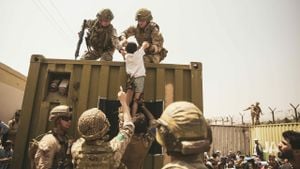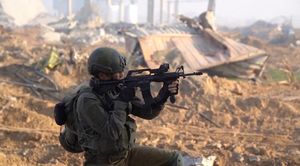Israel is currently ramping up its military presence along its northern border with Lebanon as regional tensions between the two nations escalate. This renewed military buildup has raised alarms, especially with fears surrounding the capabilities of Hezbollah, the Lebanese militant group, and potential retaliatory strikes from areas within Lebanon. Despite decades of conflict and various military engagements, the current atmosphere exemplifies the cyclical nature of violence and strategic posturing found within Middle Eastern geopolitics.
Reports from various sources indicate alarming levels of military mobilization, with Israel allegedly intensifying airstrikes on civilian areas within Lebanese territories, reportedly resulting in substantial casualties among non-combatant populations. Such actions mirror those taken during previous conflicts, invoking memories of the 2006 war where civilian areas were heavily bombed. Intended to retaliate against Hezbollah's attacks, today’s military strategy seems aimed at both deterring potential threats and demonstrating military strength, consistent with previous practices by Israeli forces.
Hezbollah has long stood as the principal military antagonist to Israeli operations within Lebanon. Emerging from the socio-political turmoil of the early 1980s, Hezbollah characterized itself as the protector of Lebanon against Israeli aggressions, claiming legitimacy through the lens of resistance. Since its inception, it has garnered substantial support from the Shia population and positioned itself against both local and regional adversaries, aligning itself with Iran amid shared anti-Zionist sentiments.
But Israel's strategy isn't merely reactive; it has long been intertwined with aspirations of territorial expansion. Advocates of such policies suggest incorporating Lebanese territories within the broader ideological framework of ‘Greater Israel.’ This aspiration has roots dating back to the very formation of Israel, as evidenced by historical migrations during the Nakba — the mass displacement of Palestinians during the 1948 Arab-Israeli war. The onslaught of the Israeli military has consistently drawn both domestic and international condemnation, painting Israel as both aggressor and occupier over the years.
The current military maneuvers are underscored by the fear of Iranian influence within Hezbollah, augmented particularly by the introduction of advanced military technologies. The Iranian Fattah-2 hypersonic missile could theoretically allow Hezbollah to strike deep within Israeli territory if launched effectively. Such capabilities only fuel the already heightened anxieties among Israeli officials, who are concerned about the potential effectiveness of these missiles against their air defenses.
Skeptics point out the repeated failures of Israel to decisively defeat Hezbollah through military means. The 2006 conflict, often detailed as Israel's most significant military failure, resulted in considerable loss on both sides, with Hezbollah managing to withstand sustained assaults and even inflict casualties on the Israeli Defense Forces (IDF). The operational strategies employed by Israel then aimed at comprehensive destruction were met with concurrent strategic adaptations by Hezbollah, emphasizing guerilla warfare and enabling rapid responsiveness to Israeli incursions.
Fast forward to today, many observers contend Israel has refrained from fully engaging its ground forces within Lebanon, likely dissatisfied with previous outcomes. The urgency to re-establish military dominance around perceived strongholds could stem from recent escalatory exchanges along the border, where Hezbollah has launched missiles as retaliation against various Israeli actions. This exchange has not only intensified military posturing but engaged local communities who are drawn back to cycles of violence.
Despite facing military setbacks, Hezbollah remains embedded within the fabric of Lebanese society, not just as a fighting force but as a socio-political movement providing welfare, education, and health services to the Shia population. This duality complicates confrontations, as military actions against Hezbollah often come with the risk of alienation within the local communities who benefit from the group’s social programs.
International reactions toward the military dynamics between the two countries are mixed, with various nations advocating for de-escalation and seeking diplomatic channels to prevent exacerbation of hostilities. Fears of broader regional conflict loom large, as Israel's aggressiveness could draw responses not only from Hezbollah but potentially from Iranian forces allied with the group.
American officials have echoed concerns over Iranian capabilities and weapon technologies potentially being transferred to Hezbollah, asserting the group may acquire nuclear-capable assets following developments tied to Iranian missile advancements. Continued U.S. support for Israel emphasizes the delicate balance they must maintain between providing military assistance and managing increasing tensions with Iran and its proxies.
Meanwhile, the backdrop of increasing military exercises and live-fire drills perpetuates the culture of readiness within Israeli forces. The persistent apprehension surrounding Iranian ambitions has driven both Israeli and U.S. military efforts to showcase their preparedness to confront any perceived threats.
The narrative around military engagements between Israel and Hezbollah remains fraught with complexity. Each military action is carefully weighed against potential civilian impacts, with humanitarian concerns at the forefront during discussions of legitimacy and retaliation. Still, the historical blemishes of civilian casualties echo loudly through the region, forcing local populations to confront the reality of being caught within wider geopolitical battles.
The balance of power within this tense environment remains tenuous at best. Efforts to regulate engagement follow historic precedents, implying any future military altercation may warrant even more severe repercussions.
It remains to be seen how the recent military buildup will affect the regional stability or whether it will propel both groups toward another round of violent confrontation. The interplay of military readiness, local sentiments, and geopolitical maneuvers continues to frame this fraught narrative.



